An Approximate Proximal Numerical Procedure Concerning the Generalized Method of Lines
Abstract
:1. Introduction
2. The Numerical Method
3. A Numerical Example
4. A General Proximal Explicit Approach
- For[i = 1, i < m8 + 1, i++,uo[i] = 0.0];
- For[k = 1, k < 150, k++,Print[k];a[1] = 1/(2.0 + );b[1] = a[1];c[1] = a[1]*(K*uo[1] + 1.0)*;For[i = 2, i < m8, i++,a[i] =b[i] = a[i]*(b[i - 1] + 1);c[i] = a[i]*(c[i - 1] + ];
- u[m8] = uf[x]; d1 = 1.0;
- For[i = 1, i < m8, i++,t[m8 - i] = 1 + (m8 - i)*d;A1 = (a[m8 - i]*u[m8 - i + 1] +b[m8 - i]*(-A* + B*u[m8 - i + 1])* +c[m8 - i] +*b[m8 - i]*(D[u[m8 - i + 1], x, 2]/) +*b[m8 - i]* (uo[m8 - i + 1] - uo[m8 - i])/d)/(1.0);A1 = Expand[A1];A1 = Series[ A1, {uf[x], 0, 3}, {uf’[x], 0, 1}, {uf”[x], 0, 1}, {uf”’[x], 0, 0}, {uf””[x], 0, 0}];A1 = Normal[A1];u[m8 - i] = Expand[A1]];For[i = 1, i < m8 + 1, i++,uo[i] = u[i]]; d1 = 1.0;Print[Expand[u[m8/2]]]]
5. Conclusions
Funding
Conflicts of Interest
References
- Botelho, F. Topics on Functional Analysis, Calculus of Variations and Duality; Academic Publications: Sofia, Bulgaria, 2011. [Google Scholar]
- Botelho, F. Existence of Solution for the Ginzburg-Landau System, a Related Optimal Control Problem and Its Computation by the Generalized Method of Lines. Appl. Math. Comput. 2012, 218, 11976–11989. [Google Scholar] [CrossRef]
- Botelho, F. Functional Analysis and Applied Optimization in Banach Spaces; Springer: Cham, Switzerland, 2014. [Google Scholar]
- Botelho, F.S. Functional Analysis, Calculus of Variations and Numerical Methods in Physics and Engineering; CRC Taylor and Francis: Boca Raton, FL, USA, 2020. [Google Scholar]
- Adams, R.A. Sobolev Spaces; Academic Press: New York, NY, USA, 1975. [Google Scholar]
- Adams, R.A.; Fournier, J.F. Sobolev Spaces, 2nd ed.; Elsevier: New York, NY, USA, 2003. [Google Scholar]
- Annet, J.F. Superconductivity, Superfluids and Condensates, 2nd ed.; Oxford Master Series in Condensed Matter Physics; Oxford University Press: Oxford, UK, 2010; Reprint. [Google Scholar]
- Landau, L.D.; Lifschits, E.M. Course of Theoretical Physics, Volume 5—Statistical Physics, Part 1; Elsevier, Butterworth-Heinemann: Oxford, UK, 2008; Reprint. [Google Scholar]
- Toland, J.F. A duality principle for non-convex optimisation and the calculus of variations. Arch. Rath. Mech. Anal. 1979, 71, 41–61. [Google Scholar] [CrossRef]
- Strikwerda, J.C. Finite Difference Schemes and Partial Differential Equations, 2nd ed.; SIAM: Philadelphia, PA, USA, 2004. [Google Scholar]



Publisher’s Note: MDPI stays neutral with regard to jurisdictional claims in published maps and institutional affiliations. |
© 2022 by the author. Licensee MDPI, Basel, Switzerland. This article is an open access article distributed under the terms and conditions of the Creative Commons Attribution (CC BY) license (https://creativecommons.org/licenses/by/4.0/).
Share and Cite
Botelho, F.S. An Approximate Proximal Numerical Procedure Concerning the Generalized Method of Lines. Mathematics 2022, 10, 2950. https://doi.org/10.3390/math10162950
Botelho FS. An Approximate Proximal Numerical Procedure Concerning the Generalized Method of Lines. Mathematics. 2022; 10(16):2950. https://doi.org/10.3390/math10162950
Chicago/Turabian StyleBotelho, Fabio Silva. 2022. "An Approximate Proximal Numerical Procedure Concerning the Generalized Method of Lines" Mathematics 10, no. 16: 2950. https://doi.org/10.3390/math10162950
APA StyleBotelho, F. S. (2022). An Approximate Proximal Numerical Procedure Concerning the Generalized Method of Lines. Mathematics, 10(16), 2950. https://doi.org/10.3390/math10162950




